If you’re considering whitewashing or limewashing your brick fireplace, you may be wondering which is the better option. Both techniques have their pros and cons, and in the end it comes down to personal preference. In this article, we will discuss the differences between limewash and whitewash, and help you decide which is the best option for you.
What is limewash?
Limewash is a water-based paint made from limestone that has been slaked, or mixed with water. It has been used for centuries as a finish for both indoor and outdoor surfaces.
Limewash is highly alkaline, which gives it excellent properties for binding to surfaces like brick or stone. This makes it an ideal choice for finishing fireplace surrounds.
Limewash is also very breathable, which means it allows moisture to evaporate from the surface of the bricks. This is important because bricks are porous and can absorb moisture from the air.
Breathability also helps to prevent efflorescence, which is when salt deposits form on the surface of bricks. Efflorescence can cause the bricks to deteriorate and can be difficult to remove.
Limewash is available in a variety of colors, from white to light gray. It can also be tinted with any water-based paint color.
Pros of limewash
- Limewash is much cheaper than whitewash.
- Limewash is easier to apply than whitewash.
- Limewash does not require a primer.
- Limewash gets better results on porous surfaces.
Cons of limewash
- If it’s not mixed properly, the limewash can be streaky.
- Limewash can be difficult to remove if you don’t like the look.
- Limewash may need to be reapplied more often than whitewash.
Overall, limewash is the better option if you’re looking for a cheaper, easier to apply, and more durable solution. However, it’s important to keep in mind that limewash can be difficult to remove if you don’t like the look. If you decide to go with whitewash, be sure to follow the instructions carefully so you don’t end up with a streaky mess. [1]
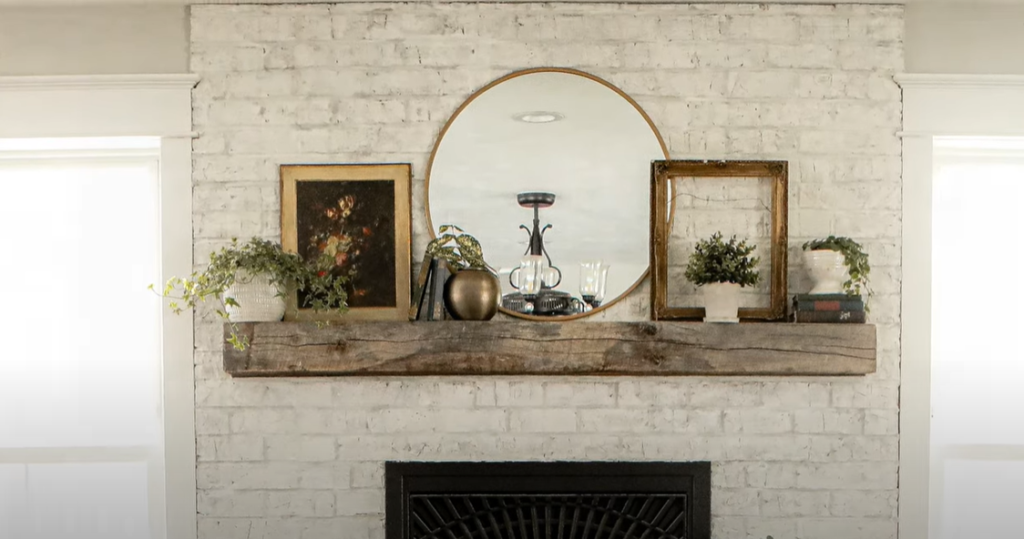
How to apply limewash?
Applying limewash is a relatively simple process. All you need is a bucket of limewash, a brush, and some water. Start by mixing the limewash with water until it reaches a consistency that you’re happy with. Then, simply apply the mixture to your fireplace using the brush. Make sure to evenly cover all of the bricks. Once you’re finished, let the limewash dry for 24 hours before lighting a fire.
There are a few things to keep in mind when limewashing your fireplace. First, limewash will lighten the color of your bricks. If you want to maintain the original color of your bricks, you’ll need to use a different method. Second, the limewash can be difficult to remove once it’s applied. So if you’re not happy with the results, you may be stuck with them. Finally, because limewash is made from lime, it’s corrosive. This means that it can damage metal fireplaces. If you have a metal fireplace, you’ll need to take extra care when applying the limewash. [2]
What is whitewash?
Whitewash is a paint made of lime and water that is used to whiten surfaces. It has been used for centuries to whiten walls, ceilings, and other surfaces. Limewash is also sometimes called calcium hydroxide or slaked lime.
Limewash is similar to whitewash, but it uses limestone instead of lime. Limewash has a chalky appearance and can be used indoors or outdoors. It is often used on brick fireplaces because it gives the bricks a weathered look. [3]
Both limewash and whitewash are durable and easy to apply. They can both be applied with a brush, roller, or sprayer.
Pros of whitewash
- Easier to apply
- More forgiving
- Can be applied in one coat
- Great for a distressed look
If you are looking for a more traditional feel or want to achieve an antique look, whitewashing is the way to go. It can also be a great option if you are working with bricks that are already in good condition and don’t need as much coverage. Whitewash is also easier to apply than limewash and is more forgiving if you make mistakes. Plus, it can usually be done in just one coat. And if you’re going for a shabby chic or distressed look, whitewashing is perfect.
Cons of whitewash
- Temporary
- Can be difficult to remove
- Bricks can be damaged during removal
However, one downside of whitewash is that it is only temporary. It can also be difficult to remove if you decide you want to change the look of your fireplace down the road. And because it’s applied directly to the bricks, there is a risk of damaging them during the removal process.
Overall, both limewash and whitewash have their pros and cons. It really comes down to personal preference and the look you are trying to achieve. If you’re not sure which route to go, we recommend talking to a professional before making a decision. They can help you weigh your options and choose the best option for your fireplace.
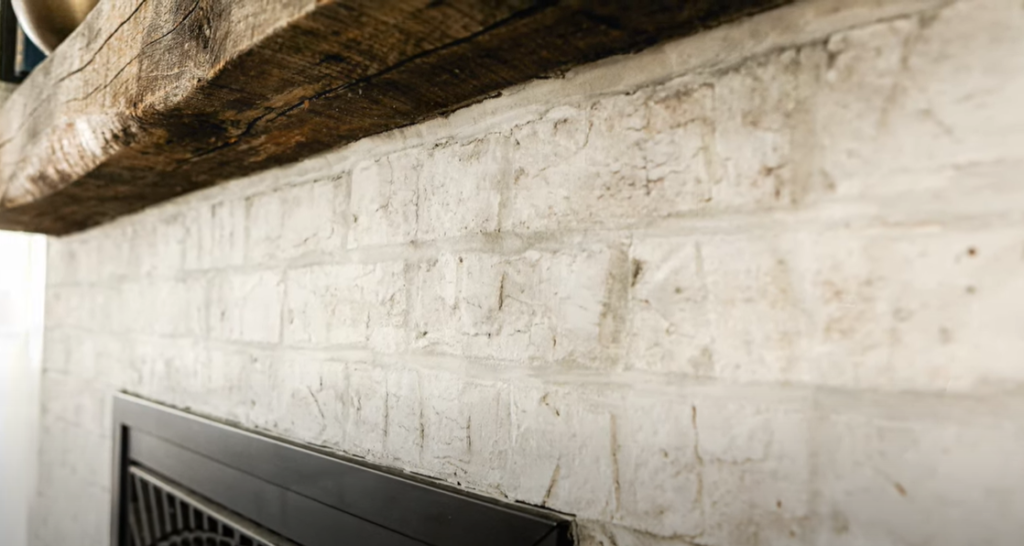
How to apply whitewash?
Applying whitewash is a simple process that doesn’t require any special skills or knowledge. All you need is a clean brush and a bucket of whitewash. Simply dip your brush into the whitewash and then apply it to the brick surface. Start from the top and work your way down in even strokes. Once you’re done, let the whitewash dry for 24 hours before using the fireplace. [4]
Are there any other options besides limewash and whitewash?
If you want to keep your brick fireplace looking natural, there are a few other options besides limewash and whitewash. One option is to simply seal the brick with a clear sealer. This will protect the brick from dirt and stains without changing its color.
Another option is to paint the brick fireplace with a high-heat-resistant paint. This is a good choice if you want to change the color of your fireplace without using harsh chemicals. However, it’s important to note that painting over brick can be difficult and time-consuming.
Now that you know more about your options, it’s time to decide which is best for you. If you’re looking for a quick and easy solution, limewash is probably the way to go. However, if you want something more permanent or customizable, whitewash or painting may be better choices. Whatever you decide, be sure to take the time to do your research and choose the option that will best suit your needs.
About German Smear
When it comes to giving your home that old-world charm, nothing quite does the trick like a German smear or whitewash.
Also known as “mortar wash” or “slurry coat,” German Smear is a technique that involves applying a thin layer of mortar over the bricks on your fireplace. This gives the bricks an aged look and helps to disguise any imperfections. The best part about this method is that it’s relatively easy to do yourself and doesn’t require any special tools or materials.
Pros of German Smear
The first thing you’ll notice with the German Smear technique is that it gives your fireplace an instant makeover. It’s a great way to achieve a new look without having to replace any brickwork.
Another big advantage of German Smearing is that it can help to disguise any imperfections in the brickwork. If your fireplace has any cracks or chips, they will be much less noticeable once the mortar has been applied.
German Smearing can also be used to create a variety of different looks. If you want a more rustic feel, you can leave the bricks unpainted. Or if you prefer a cleaner look, you can paint the bricks before applying the mortar.
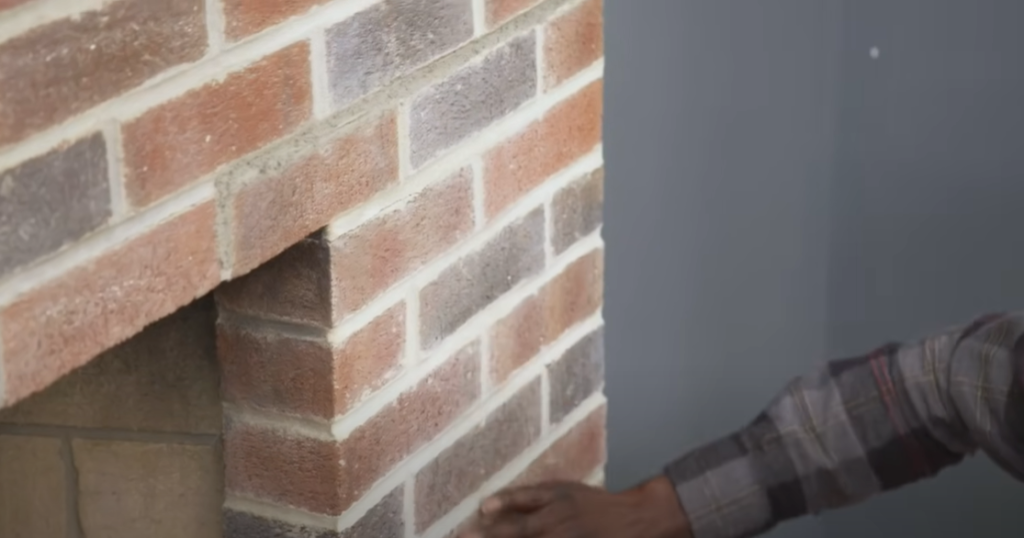
Cons of German Smear
The German Smear technique requires a lot of elbow grease. It’s a very hands-on process that can be quite messy. You’ll need to be prepared to get dirty and spend some time on this project.
This is a relatively permanent solution for your fireplace. Once you’ve applied the German Smear, it will be difficult to remove it without damaging the bricks. [5]
If you’re not happy with the results of your German Smear, you may need to hire a professional to fix it for you. This can be costly and time-consuming.
Which technique should I choose for my home?
The answer to that question depends on a few factors. If you want a more natural or “rustic” look, then limewash is the way to go. It will also be a bit easier to apply since it doesn’t require as much prep work as whitewash does.
If you want a cleaner and brighter look, then whitewash is probably your best bet. It does require a bit more elbow grease to get it right, but the results are definitely worth it.
Whichever technique you choose, make sure you take the time to do it right. A good rule of thumb is to always test out your chosen method on a small section of brick before doing the whole fireplace.
Comparison of Limewash and Whitewash for Brick Fireplaces
Deciding between limewash and whitewash for your brick fireplace involves various considerations. Below is a comparison of these two methods, helping you determine which is better for your fireplace makeover.
| Consideration | Limewash | Whitewash |
|---|---|---|
| Application Process | Requires mixing lime with water to create a paste and then applying it to the brick surface. | Involves thinning paint with water and applying it to the brick. Simpler application process. |
| Texture and Finish | Creates a matte, chalky finish with a texture that allows the natural brick to show through. | Results in a semi-transparent, distressed look that still lets the brick texture shine. |
| Color Options | Limited color choices, typically in shades of white or off-white. | Offers more color variety, including different shades and tints of white or other colors. |
| Durability | Durable and long-lasting, capable of withstanding outdoor exposure and weather conditions. | Relatively durable for interior use but may require occasional touch-ups over time. |
| Coverage | Provides excellent coverage and is effective at concealing the original brick color. | Provides good coverage, but the original brick color may show through slightly. |
| Cost | Cost-effective for a large area due to minimal material expenses. | Reasonably priced, with paint being the primary expense, but additional coats may be needed. |
Explanation of the table:
- The table provides a comparison of limewash and whitewash for brick fireplaces, including considerations related to the application process, texture and finish, color options, durability, coverage, and cost.
- Each consideration is described, highlighting the differences between the two methods to assist you in making an informed decision for your fireplace makeover.
FAQ
Should you whitewash or limewash your fireplace?
It depends on the look you’re going for. If you want a more traditional look, then whitewash is probably your best bet. If you’re looking for something a little more contemporary, then limewash might be a better option.
Here are a few things to keep in mind when making your decision:
- Whitewash will give your fireplace a brighter, more clean look.
- Limewash can be applied in thinner coats, which means it’s less likely to chip or flake off over time.
- Whitewash is typically cheaper than limewash.
- Limewash is available in a variety of colors, so you can really customize the look of your fireplace. [6]
What is the difference between limewash and whitewash?
Limewash is made with limestone while whitewash is made with slaked lime. Limestone is a sedimentary rock that’s formed from the remains of marine organisms. Slaked lime, on the other hand, is produced by burning limestone in a kiln and then adding water to it.
Another key difference is that limewash tends to be more expensive than whitewash. This is because it’s a more labor-intensive process to produce limewash. In addition, limewash also requires more time to dry than whitewash does.
Is it better to limewash or paint brick?
This is a question we get a lot, and there is no easy answer. It depends on many factors, such as the type of brick, the condition of the brick, and the desired look.
For example, if you have an older home with beautiful historic bricks, you may not want to cover them up with paint. Or if your brick is in good condition and you just want to change the color, limewash may be the better option.
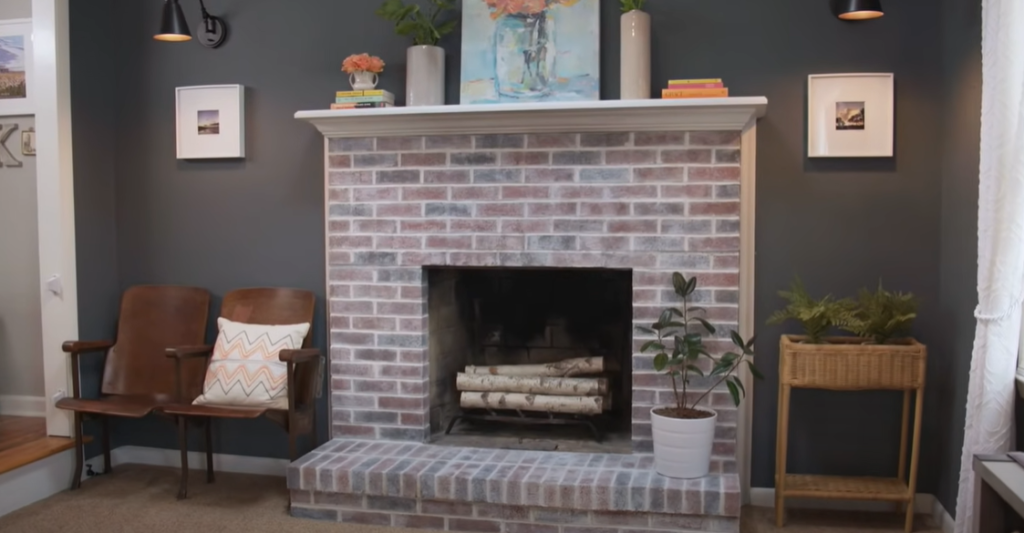
What is paint brick?
Paint brick is a process where a layer of paint is applied to the brick surface. This can be done with a brush, roller, or even sprayer. Paint will completely cover the bricks and change the color.
What is limewash?
Limewash is a traditional method of painting bricks that has been used for centuries. It uses slaked lime mixed with water to create a wash that is applied to the bricks. Limewash does not completely cover the bricks like paint does, but rather it creates a weathered look that allows some of the brick texture to show through.
So, which is better? As we said, it depends. If you want to maintain the historic look of your home, limewash is probably the better option. If you only want to alter the color of your brick fireplace, however, whitewashing may be a better alternative.
How long does whitewash brick last?
The lifespan of a whitewash brick fireplace is about four to five years. After that, the bricks will start to show their age and will need to be replaced.
Limewash, on the other hand, can last up to 20 years before it needs to be reapplied. This makes it a more durable option for your fireplace. [7]
So, if you’re looking for a longer-lasting solution for your fireplace, limewash is the way to go. However, if you want a more traditional look for your home, whitewash is still a great option.
What are the advantages of using limewash on a brick fireplace compared to whitewash?
Limewash offers several advantages over whitewash for a brick fireplace. It creates a matte, textured finish that allows the underlying brick texture to show through. Limewash is also highly breathable, durable, and resistant to UV damage, making it an excellent choice for long-lasting and visually appealing fireplace finishes.
What are the benefits of whitewashing a brick fireplace over using limewash?
Whitewashing a brick fireplace provides a different aesthetic compared to limewash. It imparts a more translucent, rustic, and distressed appearance to the brick, which some people find appealing. Whitewash is also a budget-friendly option and relatively easy to apply for a DIY project.
Which finish is easier to apply – limewash or whitewash – for a brick fireplace?
Whitewash is generally easier to apply for a DIY project on a brick fireplace. It typically involves a mixture of water and white paint and can be applied with a brush or rag. Limewash, on the other hand, requires a specific process that involves slaking lime and often involves more steps and materials, making it more labor-intensive.
Can you change the appearance from limewash to whitewash or vice versa on a brick fireplace once it’s applied?
It’s possible to change the appearance from limewash to whitewash or vice versa on a brick fireplace, but it can be a time-consuming and labor-intensive process. You would need to remove the existing finish, prepare the surface, and then apply the new finish of your choice.
Which finish offers better durability for a brick fireplace – limewash or whitewash?
Limewash is generally considered more durable than whitewash for a brick fireplace. Limewash is highly breathable and resistant to UV damage, making it a longer-lasting option. Whitewash may require more frequent touch-ups or reapplication to maintain its appearance.
Are there any specific considerations for choosing between limewash and whitewash based on the style of your home or fireplace?
The choice between limewash and whitewash should consider the style of your home and the desired aesthetic. Limewash tends to provide a more classic and European look, while whitewash offers a more rustic and casual appearance. Consider your home’s overall style and your personal preferences when making a decision.
Useful Video: Limewash Brick Fireplace with Romabio Limewash
Conclusion
So, what’s the verdict? Well, it depends on what you’re looking for. If you want a more natural look that will show some of the brick’s original color, then limewash is probably your best bet. On the other hand, if you want a completely white fireplace, whitewash is probably better suited for you.
Either way, both of these methods can give your fireplace a fresh new look. So go ahead and try one out – you might be surprised at how much difference it makes! Thanks for reading!
We hope this guide was helpful in answering some of your questions about limewash vs. whitewash brick fireplaces!
References:
- https://www.remodelista.com/posts/remodeling-101-limewashed-walls-limewash-paint/
- https://www.limestuff.co.uk/blog/how-to-apply-limewash
- https://www.merriam-webster.com/dictionary/whitewash
- https://www.interiorsbysarahlangtry.com/blog-posts//2013/01/how-to-apply-whitewash-finish.html
- https://www.bobvila.com/articles/german-smear/
- https://www.ringsend.com/blog/post/how-to-whitewash-a-brick-fireplace-with-limewash
- https://thefarmhouselife.com/whitewash-brick-the-pros-and-cons-painted-brick-plus-the-easiest-techniques/





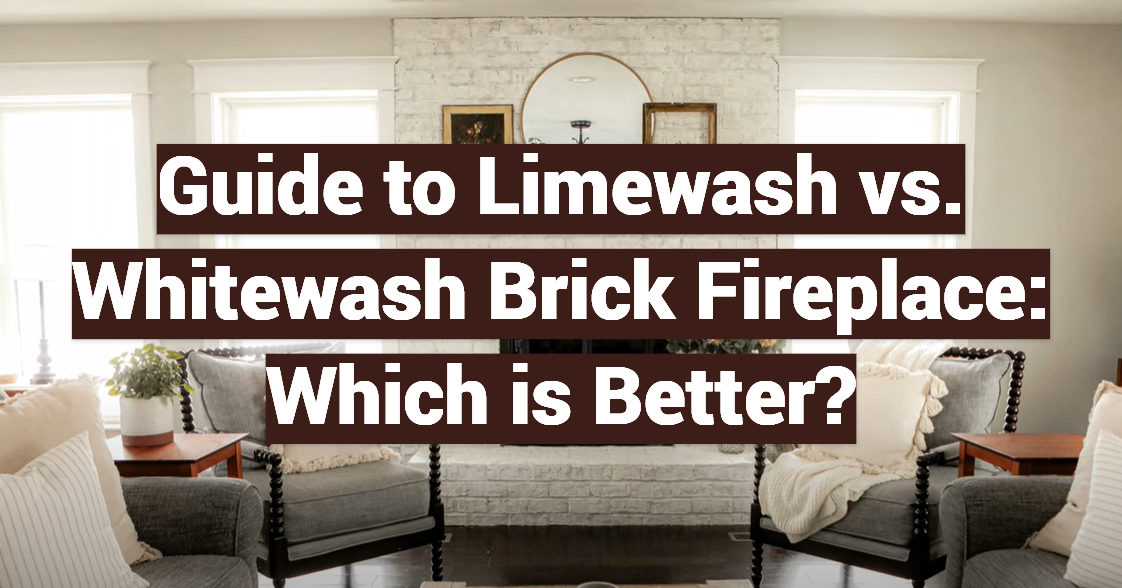








Leave a Review